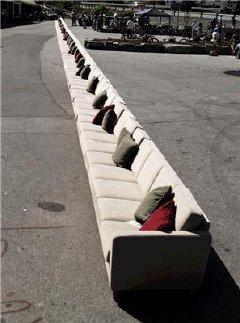Jun 15 2009
Now you can get environmental product declarations on furniture.
 The worlds longest sofa with 1500 seats: An environmental product declaration gives quantified information on the environmental import through the entire lifecycle of the piece of furniture; from the extraction of raw materials to the production at sub suppliers, transport, assembly, packaging, use and disposal at some future date. Photo: Ekornes ASA
The worlds longest sofa with 1500 seats: An environmental product declaration gives quantified information on the environmental import through the entire lifecycle of the piece of furniture; from the extraction of raw materials to the production at sub suppliers, transport, assembly, packaging, use and disposal at some future date. Photo: Ekornes ASA
A tag that comes along with the price tag can give you answer whether you can buy the sofa with good conscience.
The world's longest sofa was built this weekend in Sykkylven, Norway. More than 800 metres long, seating 1500 persons. It is also the greenest sofa so far that got an environmental product declaration. In the future you can read on a tag that comes along with the price tag whether the sofa of your choice has a large environmental impact, or not.
Exactly this sofa is pretty friendly and has 'environmental label A'. Certainly this is not an international standard yet, but maybe soon.
- Such an environmental product declaration as we created, will include all aspects of the production, tells Professor Annik Magerholm Fet at the Department of Industrial Economics and Technology Management at the Norwegian University of Science and Technology, NTNU. - The declaration gives the whole picture regarding the environmental impact. That means one can buy green sofas in any colour, with good conscience.
The environmental product declaration is based on several years of research. A software tool is developed, keeping track of all possible environmental requirements and standards, and calculates the environmental impact of each and every part of the production process; from chopping the first tree, until the sofa has legs to stand on, and the destiny of the sofa when it at some point in time no longer is a sofa anymore.
- If one does as in for example the fishing industry and produce in for example China, tells the professor, - then this will most probably be lucrative seen from a cost of production perspective, but the transport will be lead to an unnecessary impact on the environment. It is exactly this big picture on the environmental impact consumers, producers and authorities want.
It is this big picture the new environmental data tool DATSUPI (Data Assisted Tool for Sustainability Product Information) from NTNU will contribute with. DATSUPI comprises loads of information as well as integrated information from international databases for environmental information, in such a way that the tool is updated at any time. Then all that is to be done is to enter all information regarding the piece of furniture that is to be produced, and one will get a result summing up the total environmental impact.
The software tool will help companies to meet the demands for documentation for products in an international market. At the same time it can be used as a design tool to make furniture production more environmental friendly.
- When you buy food, you can read a great deal on the product declaration, whether the meat is Norwegian, about the salt content and so on. Or when you buy garden furniture or construction materials, you might think about the rain forest. The furniture industry is the first industry with a more comprehensive product declaration that not only informs what the furniture is made of and whether it is "Made in Norway".
As of today there are about 50 different types of environmental product declarations. They are usually around four to five pages with technical language, reporting all imaginable details about the piece of furniture having a large impact on the environment, or not. DATSUPI has all of this, but also includes key figures for the total environmental impact. This results in an overall calculation, enabling labelling the piece of furniture with a tag that says exactly how environment-friendly the piece of furniture is during the entire lifecycle, from raw materials till consumer product and all the way to decomposition.
Exactly this sofa in Sykkylven is pretty friendly and has 'environmental label A' per seat. Because the environmental impact per functional unit, therefore per seat, is the international standard that is used within environmental accounting.
The environmental software tool is the results of more than ten years of cooperation between NTNU and the furniture industry in the region.
The furniture companies in furniture village Sykkylven at Sunnmøre in Norway can now make great play with the world's longest sofa. The sofa is also the greenest. It has been voluntary communal work where all companies have collaborated. Arve Ekornes, director for product development at Ekornes ASA, has been the coordinator for the collaboration and is extremely satisfied.
- The collaboration with NTNU has contributed to increasing our knowledge of and consciousness for the need to have high quality environmental documentation on our products. The establishment of environmental declarations and the DATSUPI software tool is an excellent starting point for creating more environmental friendly furniture for the future.
And the world's longest sofa may look beige, but it is declared green.